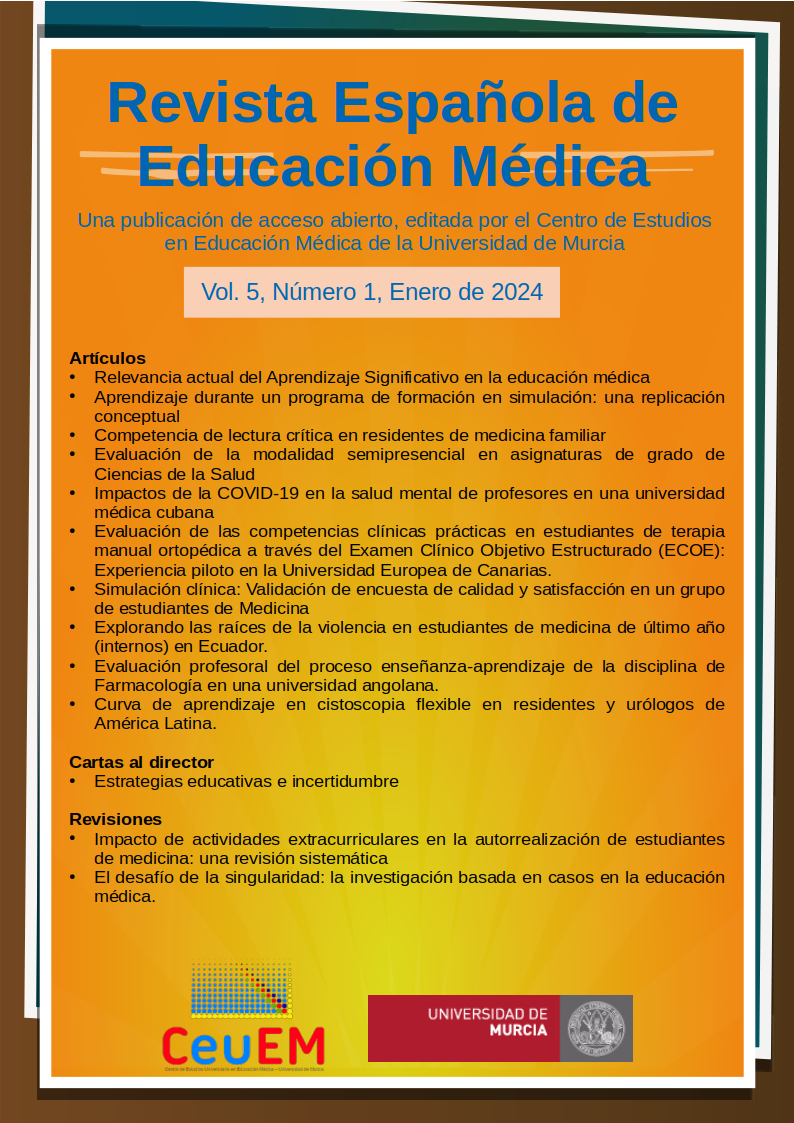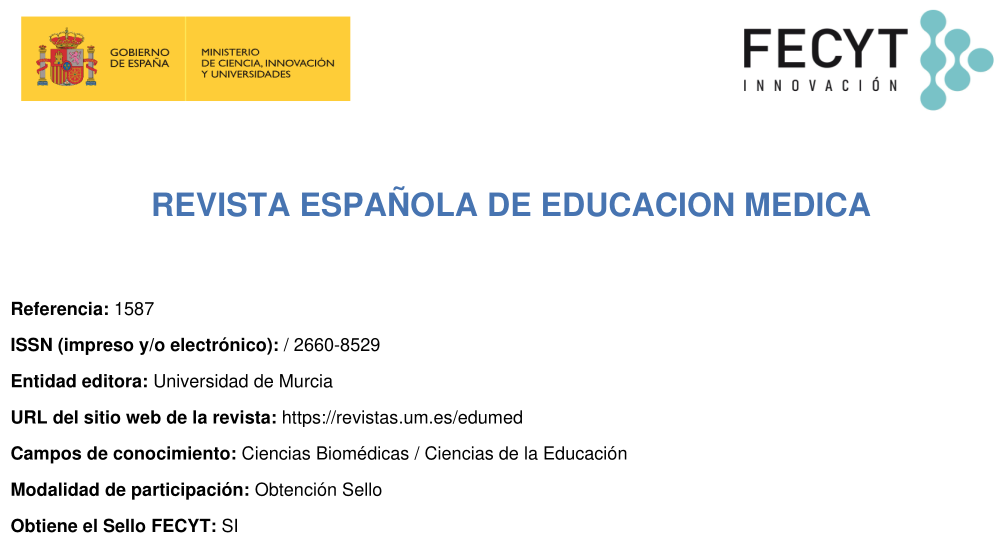Exploring the roots of violence in last year medical students (interns) in Ecuador
Abstract
Background: Medical interns are frequently victims of a hierarchical system, suffering various forms of abuse, ranging from psychological harm to sexual threats and physical assault. Objective: Determine the prevalence of violence and identify the factors that contribute to it in medical interns. Methods: Cross-sectional survey study with 161 participants. The survey “Workplace Violence in The Health Sector Country Case Studies Research Instruments Survey Questionnaire 2003” was used. Results: 59% have suffered some type of violence, 87.3% psychological violence, 3.1% physical violence and 9.4% both types of violence. In psychological violence, verbal aggression was the most prevalent (76.6%). Health personnel are the main source of violence, in psychological violence it was nursing (32.2%) and in physical violence, senior doctors (41.6%). In both types of violence, the majority perceives it as an everyday event. The cause of violence lies in the behavior of the aggressor due to abuse of authority (31%) and stress in 27%. Only 18.1% know the policies to confront violence. Most do not report the incident mainly due to fear. Conclusion: Violence towards medical students manifests itself in different ways and emanates from hierarchical positions, this can have consequences on the professional and emotional development of future doctors.
Downloads
Metrics
-
Abstract1360
-
pdf (Español (España))935
-
pdf935
-
Anexo I (Español (España))54
References
González-Amarante P, Olivares Olivares SL, Fouquet A. La visión de los estudiantes de medicina sobre su profesión: obstáculos para la transición a la perspectiva centrada en el paciente. Educ Médica. 2021;22(2):73-7. https://www.elsevier.es/es-revista-educacion-medica-71-articulo-la-vision-estudiantes-medicina-sobre-S1575181319301561
Vilchez-Cornejo J, Viera-Morón RD, Taminche-Canayo RC, Carrasco-Farfán CA, Romani L, Mendoza-Flores CR, et al. Características y factores asociados al maltrato percibido en internos de medicina en Perú. Acta Médica Perú. 2021;38(1):17-26. http://dx.doi.org/10.35663/amp.2021.381.1848
Bastías-Vega N, Pérez-Villalobos C, Alvarado-Figueroa D, Schilling-Norman MJ, Espinoza-Riffo M, Parra-Ponce P, et al. Maltrato en el pregrado de la carrera de Medicina: percepción de los estudiantes. Rev Médica Chile. 2021;149(4):617-25. doi: http://dx.doi.org/10.4067/s0034-98872021000400617
Sierra Córdova A, Zárate Cáceres J, Mejia CR. Maltrato asociado al acoso laboral a internos de Medicina en hospitales peruanos. Educ Médica Super. 2019;33(4). Disponible en: http://scielo.sld.cu/scielo.php?script=sci_abstract&pid=S0864-21412019000400004&lng=es&nrm=iso&tlng=es
Olivares SLO, Zapata JFG, Félix CMF, Prado AC, Corolla MLT, Hernández RIE, et al. Me preparo para prevenir la violencia y el acoso en estudiantes de medicina en México. Investig En Educ Médica. 2021;10(40):86-96. doi: https://doi.org/10.22201/fm.20075057e.2021.40.21388
Mejia CR, Serrano FT, Hidalgo SR, Avila YC. Factores asociados al maltrato universitario y hospitalario a estudiantes de Medicina de 7 países latinoamericanos. Educ Médica. 2022;23(4):100757. doi:10.1016/j.edumed.2022.100757
Reyes LCM, Sánchez LFB, Diaz JMO. Caracterización del bullying en estudiantes de medicina de Tunja, Boyacá. Rev Virtual Univ Católica Norte. 2015;(45):101-12. https://www.redalyc.org/pdf/1942/194239783008.pdf
Workplace Violence in the Health Sector - Country Case Study Research Instruments - Survey Questionnaire. Disponible en: https://www.who.int/publications/m/item/workplace-violence-in-the-health-sector---country-case-study-research-instruments---survey-questionnaire
Duan X, Ni X, Shi L, Zhang L, Ye Y, Mu H, et al. The impact of workplace violence on job satisfaction, job burnout, and turnover intention: the mediating role of social support. Health Qual Life Outcomes. 2019;17:93. doi:10.1186/s12955-019-1164-3
Sun L, Zhang W, Qi F, Wang Y. Gender Differences for the Prevalence and Risk Factors of Workplace Violence Among Healthcare Professionals in Shandong, China. Front Public Health. 2022;10. doi: https://doi.org/10.3389/fpubh.2022.873936
Mambrey V, Ritz-Timme S, Loerbroks A. Prevalence and correlates of workplace violence against medical assistants in Germany: a cross-sectional study. BMC Health Serv Res. 2023;23(1):350. doi:10.1186/s12913-023-09331-9
Xing K, Jiao M, Ma H, Qiao H, Hao Y, Li Y, et al. Physical Violence against General Practitioners and Nurses in Chinese Township Hospitals: A Cross-Sectional Survey. PLoS ONE. 2015;10(11):e0142954. doi:10.1371/journal.pone.0142954
Sun T, Gao L, Li F, Shi Y, Xie F, Wang J, et al. Workplace violence, psychological stress, sleep quality and subjective health in Chinese doctors: a large cross-sectional study. BMJ Open. 2017;7(12):e017182. doi:10.1136/bmjopen-2017-017182
Aliafsari Mamaghani E, Rahmani A, Hassankhani H, Zamanzadeh V, Dean S, Irajpour A, et al. Iranian nursing students’ experiences of workplace violence: a qualitative study. J Inj Violence Res. 2022;15(1):1-9. doi:10.5249/jivr.v15i1.1655
Jacobson AA, Colletti JE, Raukar NP. Horizontal Violence Toward Emergency Medicine Residents: Gender as a Risk Factor. West J Emerg Med. 2022;23(5):633-6. doi:10.5811/westjem.2022.6.55485
Messiaen M, Duba A, Boulangeat C, Boucekine M, Bourbon A, Viprey M, et al. Exposition aux violences professionnelles à l’hôpital chez les jeunes médecins : l’étude nationale MESSIAEN. L’Encéphale. 2021;47(2):114-22. doi:10.1016/j.encep.2020.05.020
Alnofaiey YH, Alnfeeiye FM, Alotaibi OM, Aloufi AA, Althobaiti SF, Aljuaid AG. Workplace violence toward emergency medicine physicians in the hospitals of Taif city, Saudi Arabia: a cross-sectional survey. BMC Emerg Med. 2022;22:59. doi:10.1186/s12873-022-00620-w
Sheikhbardsiri H, Afshar PJ, Baniasadi H, Farokhzadian J. Workplace Violence Against Prehospital Paramedic Personnel (City and Road) and Factors Related to This Type of Violence in Iran. J Interpers Violence. 2022;37(13-14):NP11683-98. doi:10.1177/0886260520967127
Hedayati Emam G, Alimohammadi H, Zolfaghari Sadrabad A, Hatamabadi H. Workplace Violence against Residents in Emergency Department and Reasons for not Reporting Them; a Cross Sectional Study. Emerg (Tehran). 2018;6(1):e7. https://www.ncbi.nlm.nih.gov/pmc/articles/PMC5827053/
Arif S, Baig LA, Shaikh S, Hashmi I, Sarwar Z, Baig ZA. Violence against health care workers in rural areas of Sindh, Pakistan. JPMA J Pak Med Assoc. 2022;72(11):2150-3. doi:10.47391/JPMA.3120
Nøland ST, Taipale H, Mahmood JI, Tyssen R. Analysis of Career Stage, Gender, and Personality and Workplace Violence in a 20-Year Nationwide Cohort of Physicians in Norway. JAMA Netw Open. 2021;4(6):e2114749. doi:10.1001/jamanetworkopen.2021.14749
Ince A, Torun P, Jadoo SAA. Workplace violence against medical students- A Turkish perspective. J Ideas Health. 2019;2(1):70-4. doi:10.47108/jidhealth.Vol2.Iss1.12
Copyright (c) 2023 Servicio de Publicaciones de la Universidad de Murcia

This work is licensed under a Creative Commons Attribution-NonCommercial-NoDerivatives 4.0 International License.
The works published in this magazine are subject to the following terms:
1. The Publications Service of the University of Murcia (the publisher) preserves the economic rights (copyright) of the published works and favors and allows them to be reused under the use license indicated in point 2.
2. The works are published under a Creative Commons Attribution-NonCommercial-NoDerivative 4.0 license.
3. Self-archiving conditions. Authors are allowed and encouraged to disseminate electronically the pre-print versions (version before being evaluated and sent to the journal) and / or post-print (version evaluated and accepted for publication) of their works before publication , since it favors its circulation and earlier diffusion and with it a possible increase in its citation and reach among the academic community.



















